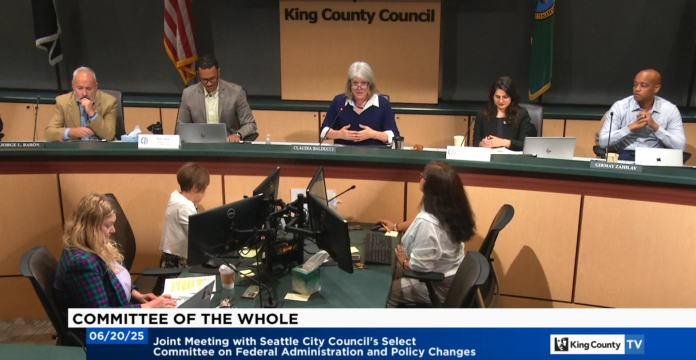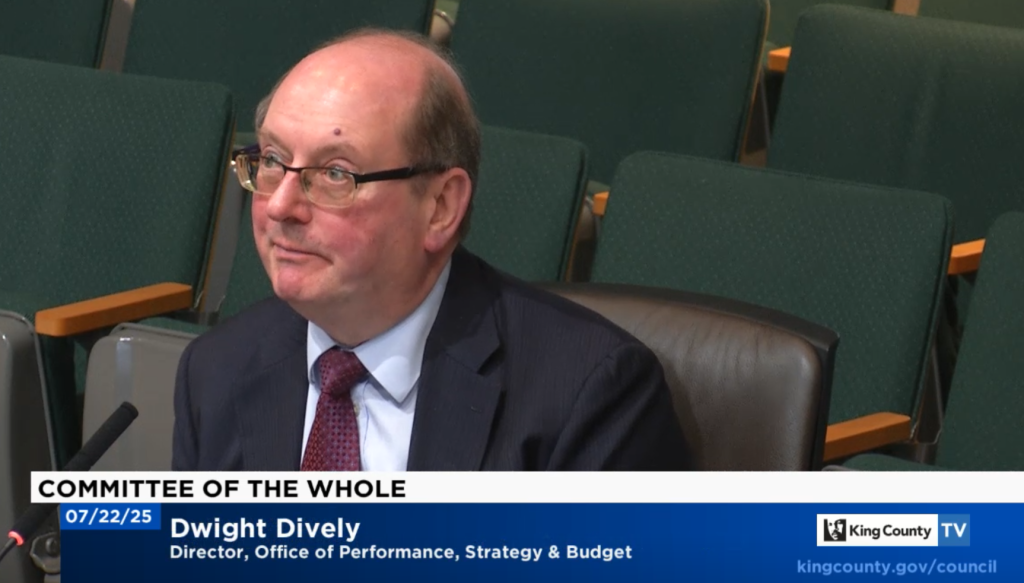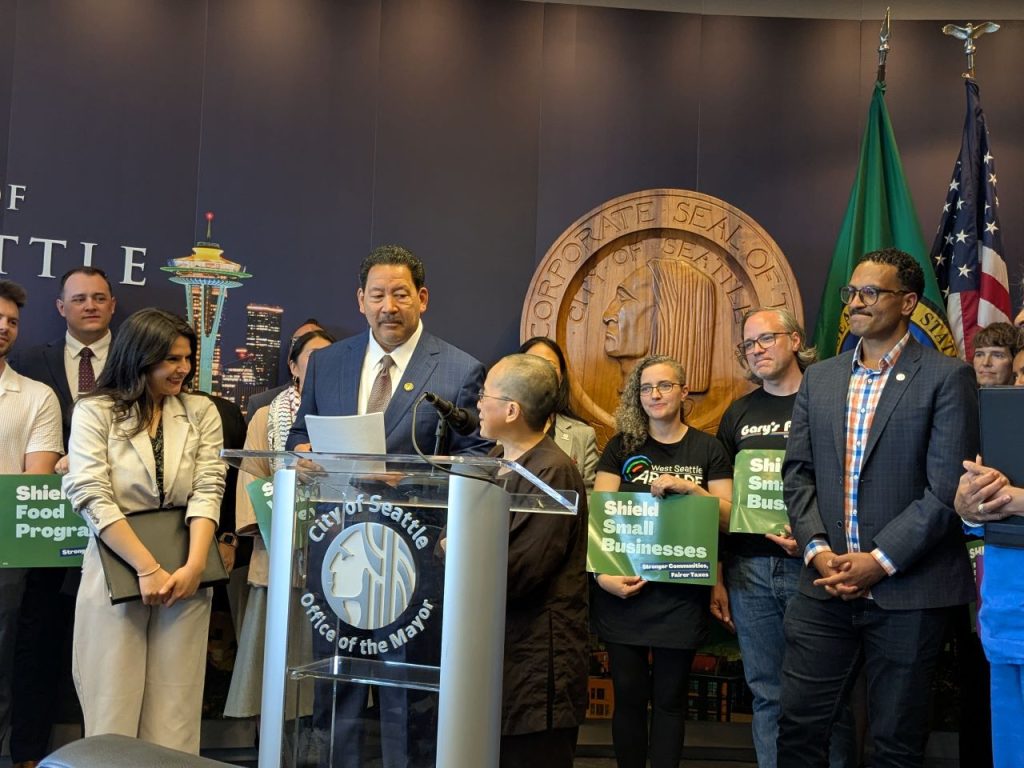
When President Donald Trump signed his budget reconciliation package on July 4, local law and policy makers began crunching numbers and trying to estimate the scale of its widespread impacts. With historic cuts to Medicaid and SNAP food benefits, as well as a huge investment in increasing ICE’s personnel and surveillance apparatus, local governments and nonprofits are scrambling to prepare as the axe begins to fall.
“This is the most regressive tax bill in half a century of federal policy,” Seattle Councilmember Alexis Mercedes Rinck said to open her recent Committee on Federal Administration and Policy Changes meeting. “The effects will be devastating and felt by the majority of Americans. Also the ultra wealthy can get another colossal tax break. So we must demand better nationally and act locally.”
Medicaid and SNAP changes
The changes to Medicaid eligibility – known as Apple Health in Washington state – will begin immediately and continue to roll out for the next few years.
“The estimates that we have seen are that somewhere between 200,000 and 320,000 Washington residents will eventually lose their Medicaid coverage,” Dwight Dively, King County’s Performance, Strategy and Budget Director, told the King County Council on Tuesday. “And public health estimates that within King County that 75,000 to 100,000 people who are currently on Medicaid will no longer be on Medicaid within two or three years, and that would essentially double our uninsured population.”

The estimates of people likely to lose their health coverage over the next few years includes people who will no longer be eligible, but it also includes a large drop-off due to the increasing requirements to qualify, which some people will find too stringent to complete, and increasing co-pays, which not everyone will be able to afford.
The Medicaid changes will also adversely affect the hospital system. As a March 2025 report from US Senator Maria Cantwell’s office states: “Medicaid funded 22.6% of inpatient care and 18.1% of outpatient care at hospitals in Western Washington in 2023. Western Washington hospitals saw 623,549 Medicaid patients in 2023.”
Over 50% of patients at Seattle Children’s Hospital are also covered by Medicaid.
The CEO of Harborview, Sommer Kleweno Walley, told the King County Council that more direct impacts to the hospital will become visible in 2026. Harborview has been able to utilize the Affordable Care Act Medicaid expansion to reduce their uninsured patient percentage from 12% to between 2-4%, but we can expect to see that number begin to rise.
Walley said that every 1% of the population that loses their Medicaid equates to about $8.4 million worth of funding for Harborview. Meanwhile, the demand for Harborview’s services will grow since they won’t turn anyone away from their emergency room.

Local community health centers will also struggle under this new burden. Right now these clinics receive anywhere from 31% to 77% of their revenue from Medicaid reimbursements. Marissa Perez, the executive director of the Seattle Human Services Coalition, told the city council that 18% of Seattle’s population relies on community health centers for primary and preventative care.
“Losing Medicaid coverage will not decrease the number of patients seeking help,” Perez said. “It will instead put extreme financial pressure on this critical safety net, resulting in worse outcomes, more medical debt, and increased medical costs across the board. While the changes are not scheduled to take place until 2026, we are already seeing changes being made to individual plans that are impacting access to care.”
As patients lose their Medicaid coverage, they will receive less preventative care and be forced to get more of their healthcare needs met at local ERs and clinics. They’ll also lose access to Medicaid-adjacent services like transportation to important medical appointments.
Trump’s proposed 2026 budget could make matters worse, with large cuts planned to health and human services and housing and urban development, including specific targets on funding for the Centers of Disease Control and Prevention (CDC) and the Federal Emergency Management Agency (FEMA).
“These cuts will undermine vital human service programs and lead to more homelessness, food insecurity, and pressure on local providers,” Perez said. She added that as Seattleites lose access to federal government assistance, they will turn to local human services agencies, who will also be struggling from funding cuts.
Anne Maher, the federal affairs director at the city’s Office of Intergovernmental Relations, said that Washington State will have to shoulder an additional $90 million for SNAP every year. SNAP-Ed, which provides education about how to make the most of SNAP benefits, is being eliminated as of October of this year. Maher said the cuts could also impact meals in schools.
“So just generally want to note that this will cause a strain on the system if people are not receiving food vouchers and then, along with health insurance, could see issues across utilities and across the board,” Maher said.
Once the US Department of Agriculture (USDA) weighs in, several changes to SNAP will take effect immediately, including increasing work requirements through age 64, eliminating exemptions for homeless people, veterans, and foster youth, and excluding refugees, asylees, and victims of human trafficking. Next year, states will be expected to shoulder significantly more of SNAP’s expenses.

Food banks are trying to prepare to face increased strain, but they have already been meeting an increased demand, with the University District Food Bank being 80% busier in households served and 130% busier in individuals served since 2023. Food has also become more expensive in the last several years due to inflation.
“For every one meal provided by food banks, SNAP provides nine,” said Joe Gruber, executive director of the University District Food Bank. “Hunger is a symptom of economic insecurity and insufficiency so families trying to survive in Seattle on $30,000 a year are left with a Sisyphean task as the safety net is willfully destroyed by the administration.”
A possible strategy to mitigate Medicaid cuts
One possible strategy for keeping as many people on Medicaid as possible in spite of federal rule changes involves more aggressive investment in long-term case management, which would be potentially cheaper for local governments than trying to outright backfill Medicaid cuts. Case managers, especially those who work within noncongregate shelter facilities, are able to find their clients relatively quickly to make sure they don’t miss deadlines and stay up-to-date with certification requirements to stay enrolled in health benefits.
“We would hope to see high-performing, long-term case management teams strengthened, scaled, and given the marching orders that this is a high priority over the next several years, and to train up on that,” said Lisa Daugaard, the co-executive director of Purpose Dignity Action (PDA). “What we shouldn’t do is defund those teams because we’re worried about backfilling Medicaid cuts. Instead, we should lean into these kinds of connections, which really have a protective ability to keep people enrolled.”
LEAD, a pre-booking diversion program, has lost about $3 million in permanent funding from the City over the last two years. Daugaard suggests the city make sure to maintain the current level of service and start to scale up the program by allocating an additional $5 million in the 2026 budget.
Daugaard also suggested that local governments use capital budget funds to acquire buildings, including tiny homes and motels, to increase housing stock, while saving other funds for case management and operating budgets. Proceeds from both the Seattle Shield Initiative and the public safety sales tax increase recently passed by King County and being considered by Seattle would be eligible for use in scaling up case management services.
In addition to the benefit to individuals of being able to continue to receive healthcare, Daugaard emphasized the greater benefit to the community at large.
“Let’s maintain and grow our Medicaid enrollment, even though that’s not what is projected, so that we can maintain a healthy and peaceful streetscape, positive environment for small business, and a general sense that Blue cities and Blue states can govern themselves,” Daugaard said.
Decreased Medicaid enrollment rates have been linked to higher crime rates, while increased enrollment rates have been linked to lower crime rates.
Seattle’s Nelson and King County Councilmember De’Sean Quinn both voiced interest in this approach in recent respective council meetings.
How Seattle and King County are responding
In the face of the federal reconciliation bill, as well as the specter of more potential federal cuts, Seattle and King County leaders are struggling to develop a plan while dealing with their own upcoming budget deficits.
Rinck, along with Seattle Mayor Bruce Harrell, has introduced the Seattle Shield Initiative to restructure the city’s B&O tax, which would decrease taxes on 90% of the city’s businesses while raising an additional $90 million per year. Part of this money would be used to backfill certain general fund investments, given the city’s projected $150 million 2026 deficit. Additionally, $30 million of the proceeds could be spent addressing federal funding cuts.

The proposal has received heated criticism from the Seattle Metropolitan Chamber of Commerce, who says the city should pass only the B&O exemption without also raising the rates on businesses with higher gross revenues. To pay for this exemption, the chamber suggests the city “fund it with the city’s accumulating cash balance in the Payroll Expense Tax fund, or through the normal budgeting process.”
Much of the balance in the Payroll Expense Tax fund, otherwise known as JumpStart, has already been allocated to affordable housing projects, which tend to take a long time to complete.
The chamber adamantly opposed the JumpStart tax and initiated a lawsuit against it after its passage in 2020. After losing their appeal, Chamber President and CEO Rachel Smith said the Chamber would be seeking “a city budget that aligns with priorities and delivers action on public safety, affordability, and homelessness.”
It is unclear how this statement aligns with the Chamber’s current desire to repurpose money intended for affordable housing.
“The same people who tried to kill JumpStart when it passed — and who still argue against progressive revenue for the city today — are now first in line to use the money it raises to close a general fund gap that exists largely because they refuse to ask the wealthiest among us to pay what they owe,” said Rian Watt, executive director of the Economic Opportunity Institute (and board vice president at The Urbanist). “We need more general fund revenue, absolutely. But JumpStart was passed with specific community needs in mind — and those needs should still take priority.”
While the Chamber thinks the Seattle Shield Initiative is a bad idea, Rinck emphasized at a recent budget meeting how regressive the state’s tax code is, saying, “The only other state in the United States that has a more business-friendly tax code than ours is the state of Florida.”
At the same meeting, Councilmember Maritza Rivera echoed the Chamber by suggested taking housing dollars that “we’re not utilizing currently” to backfill the budget deficit. Deputy Mayor Greg Wong clarified that they’ve begun collecting some housing levy money that has been promised to affordable housing projects. Voters approved the housing levy in November of 2023 to create new affordable homes and prevent homelessness through rent assistance and housing stability services – not, as Rivera was suggesting, to backfill the city’s general fund.
“I do know, though, things aren’t getting built, and this money is going to continue to come in,” Rivera said. “So if it’s not being used today, we know money is continuing to come in. We can make good down the line. […] But we have needs today, and we have money sitting somewhere today.”
While the city council considers sending the Seattle Shield Initiative to the voters this fall, and a new public safety sales tax increase might be on the horizon, Councilmember Mark Solomon called for more action on a state level in response to the federal budget bill.
“I still believe we need to find our own money to protect our people from this cruelty,” Solomon said. “We need an income tax as opposed to the regressive tax structure that we currently have that puts the burden on property owners, which then puts the burden on renters, and then puts the burden on people who buy stuff, who are adversely, in fact, affected.”
King County Councilmember Teresa Mosqueda also recently called for the state to give the county additional revenue tools, suggesting a payroll tax or a mansion tax.
“I think that’s yet another way for us to ensure that people, our most vulnerable residents, have the services that they need, but also doesn’t necessarily rely on the legislature raising revenue themselves, instead giving us the tools to do so in the largest county in the state,” Mosqueda said.
In her proposed budget, King County Executive Shannon Braddock will be creating a reserve fund in both the general fund and in the Mental Illness and Drug Dependency Behavioral Health (MIDD) Sales Tax Fund so the county can respond to future federal cuts, which the county anticipates hitting public health and behavioral health particularly hard. The council could also decide to put aside more money to temporarily backfill cuts to key local nonprofits that lose federal funding.
Both the Seattle and King County councils will have to decide how best to coordinate between themselves, the state, and key stakeholders when it comes to responding to more complicated issues like cuts to Medicaid, SNAP, emergency management, and housing.
While Councilmember Claudia Balducci wants to consider how to coordinate the most effectively, she delivered a message of hope to King County residents on Tuesday.
“I do think that we should work together as a council and with our leadership […] to think about the ways in which we can contribute to providing some political leadership in this moment, to get ready […] to be able to do what we can do, knowing that we can’t do everything, but that we can do a lot,” Balducci said.
Meanwhile, the Seattle City Council only has a few remaining weeks to act in order to get the Seattle Shield Initiative on this November’s ballots.
Amy Sundberg is the publisher of Notes from the Emerald City, a weekly newsletter on Seattle politics and policy with a particular focus on public safety, police accountability, and the criminal legal system. She also writes science fiction, fantasy, and horror novels. She is particularly fond of Seattle’s parks, where she can often be found walking her little dog.

